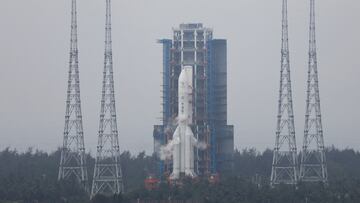China’s Chang’e-6 probe successfully lands on the far side of the Moon. What is the mission?
China pulled off for a second time a risky landing on the far side of the Moon with their unmanned Chang’e-6 probe as it gears up to send humans.

China successfully landed another spacecraft, the Chang’e-6 probe, on the far side of the Moon in the South Pole-Aitken Basin, the only nation to attempt the risky feat so far. In 2019, China landed the Chang’e-4 on the dark side of the Moon a major achievement. The challenge comes from the difficulty in communicating with a spacecraft once it has reached the space-facing side of the Moon.
Likewise, the dark side of the moon is pockmarked with deep and dark craters, and at higher latitudes the shadows are longer “which can be very confusing for landers,” says Neil Melville-Kenney, a technical officer at the European Space Agency working with China on one of the Chang’e-6 payloads, speaking to Reuters.
You may also be interested in: How many countries have landed on the Moon?
What is the mission of China’s Chang’e-6 probe on the Moon?
The Chang’e-6 probe’s mission got underway on 3 May when it launched from Wenchang Satellite Launch Center on the southern island of Hainan. It took about a week for it to reach lunar orbit. The spacecraft touched down on Sunday at 6:23 a.m. Beijing time (16:23 p.m. EDT Saturday) according to the China National Space Administration.
The Chang’e-6 craft is equipped with an array of tools including a drill and mechanical arm with a scoop. Those will be used to collect 4.4 pounds of lunar rock and soil samples over two days. The lunar material will then be loaded onto a special return capsule and launched into orbit.
📸Marvelous landing video of Chang'e 6 on the far side of the moon. Full HD:https://t.co/wcHp6Q42Sk pic.twitter.com/XY0jMIKVtL
— CNSA Watcher (@CNSAWatcher) June 2, 2024
It will rendezvous with another spacecraft which will bring the lunar material back to Earth. The samples are expected to land around 25 June in the Inner Mongolia region of China. They will be the first lunar material gathered from the far side of the Moon allowing researchers to compare their composition to those collected om the near side by the Chang’e-5 mission in 2020 as well as other samples gathered bt earlier NASA missions.
Related stories
Chinese scientists will get the first crack at studying the lunar samples before other researchers from around the world can apply to do so too. China, like other countries, hopes to exploit lunar resources in order to sustain long-term missions with astronauts and even moon bases.
China plans to put its first astronaut on the Moon around 2030 working in partnership with Russia. The US is the only nation the has achieved that feat so far, with the first moon walk in 1969.



Complete your personal details to comment